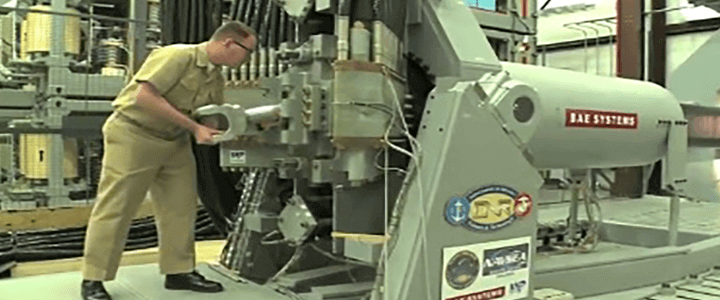The Navy recently announced its plans to take the next step towards to bringing its revolutionary electromagnetic railgun out of the laboratory and into operation. During July’s Naval Future Force Science and Technology Expo in Washington, the Office of Naval Research revealed that it will soon increase the power in its multi-shot salvo tests at the Dahlgren Naval Surface Warfare Center in Virginia.
The next step in bringing the EM railgun to the fleet will involve firing multiple rounds with a force of up to 32 megajoules. A joule is a measure of the work required to move an object. The Navy describes a megajoule as the equivalent of a “one-ton vehicle moving at 100 mph.”
ELECTROMAGNETISM INSTEAD OF CHEMICAL PROPELLANT
Since the invention of gunpowder, humans have shot projectiles at each other using explosions. Advances in ballistics have mainly involved using better propellants, better projectiles, or better gun barrels. At it most basic, a railgun is two electrically charged metal bars, with a solid projectile completing the circuit. A physical phenomenon known as the Lorenz force accelerates the projectile along the rails to hypersonic speeds.
The idea has been around for a century. A French inventor, Andre Louis Octave Fauchon-Villeplee, proposed the first “electric apparatus for propelling projectiles” in 1918, for which he received a U.S. patent in 1922. Germany made advances in railgun research as part of its anti-aircraft defenses during the Second World War, but were unable to overcome the massive power requirements.
Like the armor-piercing, fin-stabilized discarding sabot rounds fired by modern tanks, railgun projectiles rely purely on kinetic force, rather than explosions, to kill their targets. But a typical 120mm tank round has a muzzle velocity of around 5,700 feet per second and is accurate at a range of around two miles. The Navy’s railgun prototypes, by contrast, are firing projectiles at speeds up to 8,200 feet per second, or 5,600 miles per hour, and can travel more than 100 nautical miles.
Besides the massive power requirements, railguns are also limited by the fact that their barrels have a relatively short lifespan because of the excessive heat generated by the friction of the projectile along the rails.
OUT OF THE LAB AND INTO THE FLEET (AND FIELD)
The Navy’s current program began with a call for proposals from the commander of its Program Executive Office (Ships) in 2001. Funding began in 2005, and by 2010 the government-built prototype was firing projectiles at a world-record setting 33 megajoules.
Five years ago, two industry prototypes from BAE Systems and General Atomics arrived at Dahlgren for further testing and development. The latest versions are closer to firing multiple rounds per minute with, in the words of the ONR, “a tactically relevant barrel life.” In addition to the testing on land in Virginia, a test gun was mounted on a Joint High Speed Vessel in 2016.
Successful development of a viable railgun represents more than just the future of naval surface warfare. In his National Press Club address last week, the Army’s chief of staff, Gen. Mark Milley, mentioned to the idea of integrating railguns into plans for a future ground combat vehicle.
The immediate attraction of railguns, aside from the extended range they provide, is the fact that since they don’t use chemical propellant, there is a smaller risk of fire aboard the vessel or vehicle. Kinetic rounds create intense heat on impact, setting fire to anything flammable nearby.
If the upcoming tests are successful, the Navy will be one step closer to deploying a massive leap in warfighting technology. Stay tuned for updates.




